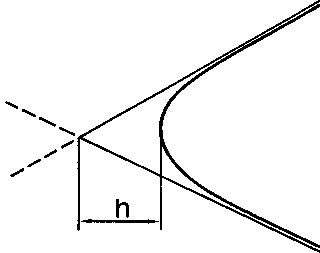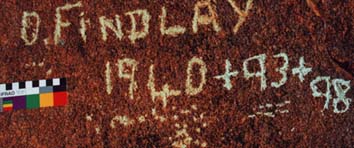Other methods
 Figure 7. The development of sandstone wanes as assumed by Cernohouz and Solc (1966).
Formula 3.
Figure 8. Multiple dates inscription, at Spear Hill rock art complex, Western Australia, showing variation in degree of repatination.
|
A group of radiometric or isotopic methods, uranium-series dating, is based on the decay series of the uranium isotopes to lead. Uranium-238 is by far the most abundant radioactive element in the Earth’s crust, consequently its decay products are widely dispersed in the lithosphere. Precipitated in surface minerals it produces daughter isotopes, and where this process occurs in a closed system, it provides a good measure of the length of time since the formation of the mineral. Several specific decay processes have been used for dating, whose relevance and applicability depends upon their effective time range (determined by the half-life of the decaying isotope) and sample availability. In rock art dating we deal usually with Late Pleistocene and Holocene ages, and in this range only 230Th/234U, 231Pa/235U, 226Ra, 231Pa/230Th and 230Th/232Th may be relevant. The preferred materials for analysis are carbonates (particularly reprecipitated carbonates, such as travertines, speleothems, corals and marl, also mollusc shells, bone and teeth) but other materials may be suitable. Only one of these methods has ever been applied to rock art, thorium-uranium dating. It was used to estimate the minimum ages of two petroglyph traditions in Malangine Cave, South Australia, which were both concealed by subsequent secondary calcite skins (speleothems). Among the results is one of the oldest credible rock art dates currently available, the conservative minimum age of 28 000 +/- 2000 years BP for Karake-type petroglyphs on the ceiling of the cave (Bednarik 1999).
The number of dating techniques that have potential applications in rock art dating but have apparently never been used is considerably greater than the number of those that have been applied. Even in the case of rock varnish, whose significance to direct rock art dating is beyond dispute, several dating methods appear to be more reliable than the much-used but now discredited CR technique. For instance, it is self-evident that this ferromanganous accretion would be well suited to palaeomagnetic dating, and yet none of the projects favouring CR dating has included a comparative study using this method (Clayton et al. 1990). Uranium was known to precipitate with the Mn-oxides of rock varnish even before the CR method was conceived (Knauss and Ku 1980) and uranium-series dating would provide more reliable information than the supposed leaching indices derived from the ratio of three cations. Rock varnishes contain clays that may be susceptible to potassium-argon dating where their ages are great enough, and if they conceal any quartz grains these may be datable by luminescence analysis. The latter would also offer far more reliable estimates of minimum age than the CR method is likely to provide, and yet again no comparative study has been attempted by the protagonists of CR dating.
The use of potassium-argon analysis may seem a desperate measure in this context, because it is widely seen as a method specifically for analysing lava flows of the middle time range (Miocene to Middle Pleistocene), but the method has been used even for Holocene materials (Evernden and Curtis 1965: 349; Miller 1970) and the half-life of 40K (1.3 billion years) provides an effective range covering much of our planet’s history. Also, the method can be applied to a wide variety of materials, including muscovite, biotite, orthoclase, microline, leucite, sanidine, obsidian, glauconite, illite, carnallite and others (Gentner and Lippolt 1970). Recent lava flows, tuffs and sedimentary rocks containing such minerals are often directly related to petroglyphs, and in such cases 40Ar/40K dating would be relevant. An alternative version of the method, intended to overcome the often non-homogenous distribution of the 40K, is to irradiate the sample in a nuclear reactor to convert the 39K into 39Ar. The sample is then heated progressively to record the ratios of 39Ar/40Ar or 36Ar/40Ar, and 39Ar/36Ar. The slope of the curve of plotting the ratio 40Ar/36Ar against that of 39Ar/36Ar will be related to the age of the specimen (Miller 1970).
Besides these and other technologically complex potential methods for rock art age estimation, there are various readily available approaches that attract no interest. For instance, the formation of macro-wanes on rock is clearly time-related, and the processes involved seem reasonably straightforward. Just as the penetration rates of weathering processes are greatly influenced by surface contour (rocks weather faster on convex aspects), erosion affects protruding aspects more than flat surfaces. Cernohouz and Solc (1966) have described a method for determining the ages of blunted edges on sandstone that uses two constants (a and b), the angle of the edge (phi) and the distance of retreat at the edge (h, in cm) (see Formula 3 above).
Time t is thus obtained in millennia. While the intent of Cernohouz and Solc is admirable, their theoretical model is false. Their dimension h is inten-ded as a measure of retreat from the original sharp edge (Figure 7, above). However, the rock not only recedes at the edge, but also on the two surfaces forming the edge. The reason for the wane formation is precisely that the retreat proceeds markedly faster from the edge than from the flat surfaces. It should also be noted that the retreat of the edge does not occur as the circular curvature shown by Ollier (1969: Fig. 149), it consists of a hyperbola in section (Bednarik 1979: 28). Dimension h is therefore measured from the hypothetical section of two asymptotes, whose position cannot be determined numerically; therefore h cannot be measured. However, the underlying geometric principles of wane formation were subsequently explained (Bednarik 1992), and they apply to macro-wanes as much as to micro-wanes. No further research has been undertaken into using macro-wanes in geomorphic or rock art age estimation work.
Cernohouz and Solc (1966) also examined weathering rinds of basalts, and such features have briefly been discussed above (see Patination and weathering). They would be particularly useful in examining relative sequences of spalling facets such as those found on gabbro and granophyre boulders (Bednarik 1979: Fig. 1), which bear literally millions of petroglyphs worldwide. The progressive reduction of a boulder through fracture, by whatever spalling process, results in many scars, most of which are truncated by other scars. The chronological sequence of the spalling events can be reconstructed. If there are petroglyphs present on one or more of the facet surfaces, they are of necessity younger than the particular surface they are engraved on, but if they themselves have been truncated by a later spalling event, it must postdate them. This facilitates two potential analytical approaches. First, the various spalls, including any bearing truncated petroglyphs, may be found within datable sediment. Second, the chronological sequence of the spalling facets is reflected in patination of ages corresponding to each spalling event. Each and every fracture of a boulder results in two new surfaces and two new edges. Both the surfaces and edges may be datable entities, and it is clear that the rock art concerned occupies a discrete chronological position within this entire sequence of surfaces and edges. Its age relative to these surface features can be determined with complete confidence, and its radiometric age may be obtainable.
The idea of using patination and weathering in estimating the age of petroglyphs is in the order of two centuries old, but so far very little tangible progress has been made in using such indices in geomorphic dating (for summary, see Knuepfer 1994), and practically none in rock art dating. Weathering rinds remain poorly understood and it would be premature to suggest that the many variables accounting for them can be quantified satisfactorily (cf. Bednarik 1979: Fig 2 for an attempt).
Belzoni’s (1820) idea of quantifying patination variations in petroglyphs has certainly been shared by many rock art researchers since, but not one has ever made a credible attempt to test it. The majority of descriptive or ‘analytical’ publications about petroglyphs contain comments on states of repatination and their relevance to antiquity, but hardly any of them even attempt to define the type of patination. The term ‘patina’ describes merely a visually obvious skin on rock surfaces which differs in colour or chemical composition from the unaltered rock and whose development is a function of time. It can be additive or accretionary, it can be reductive (result of solution), or it can have involved not a change in bulk, but one in the composition or surface characteristics of the substrate. In other words, stating that there is a change in colour with time without saying what caused it, or without quantifying that change and calibrating it with reference to time, is of no consequence to the matter at hand. Moreover, stating that repatination has occurred is of little help if the form of ‘patination’ is not adequately described. Some 180 years after Belzoni presented his idea, I have attempted to address his question. Having discovered a series of dozens of dates hammered into a few granite boulders, which show distinctive scaling of colour relative to their ages, I have recently conducted a colorimetric analysis of them (Figure 8, above). Using the IFRAO Standard Scale and appropriate computer software to re-constitute true colours with very high precision, I have plotted the measured colour changes against time, arriving at interesting and consistent results (Bednarik in prep.). This experiment was conducted on rock almost identical to that referred to by Belzoni (coarse granite), in a region of very similar climate, the Australian Pilbara (very dry, sub-tropical), so it does provide a valid answer to him. It does not, however, provide the means for dating all repatinated petroglyphs.
To some degree this reflects the state of the art of petroglyph dating: after neglecting this field of research by leaving it to archaeologists to argue about, it is at last being taken seriously since the 1980s. However, due to the tendency of some influential archaeologists to attempt monopolising rock art research, the question of rock art dating remains in its infancy, if not embryonic; catching up with the rest of science will require decades of effort.
Erosion retreat, previously also called ‘micro erosion’ analysis, is of quite limited application in rock art analysis but it must be mentioned here because some archaeologists have confused it with microerosion dating (e.g. A. Rosenfeld, cited in Zilhao 1995). ‘Micro erosion’ is actually a misnomer, as it deals with processes that occur at the macroscopic rather than the microscopic level, and a more suitable name is ‘erosion retreat analysis’. It refers to the measurement of the retreat of rapidly eroding rock surfaces, especially those on sedimentary rocks (High and Hanna 1970; Atkinson and Smith 1976). Its primary use would be in rock art conservation research rather than dating applications. This retreat may be attributable to solution or granular exfoliation, and is often a combination of the two processes.
Essentially the method involves the use of an engineering precision dial gauge mounted on a frame supported by three legs, and the placement on the rock of a reference stud (Smith 1978). With this instrument, the gradual retreat of a rock surface can be monitored over a period of many years, and the data so gathered can provide good information concerning petroglyphs that have been subjected to similar surface retreat. Obviously this method would only be applicable to relatively recent rock art on such rocks as limestone and carbonate-cemented sandstone. However, it has not been used for estimating the age of any rock art so far and is likely to be of only limited applicability.
Rock art dating – back to the main page
References list for rock art dating

